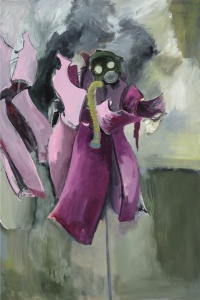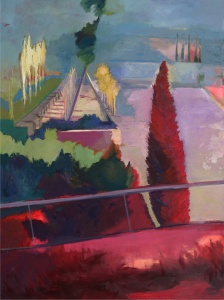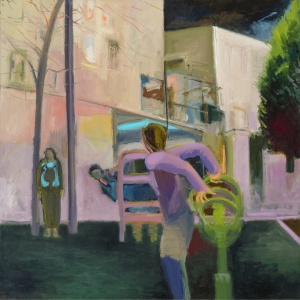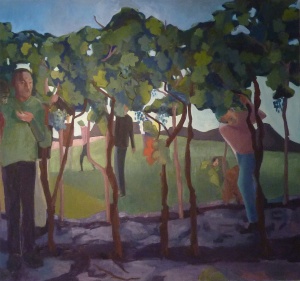Paintings by Leah Raab and Shany Saar, NY Studio School, MFA Thesis Exhibition
Whether it is the disastrous report of the 12 spies or the furious condemnation that doomed an entire generation to die in the wilderness, the Torah narrative in Bamidbar turns terribly grim after the glorious inauguration of the mishkan in the second year after leaving Egypt. With this in mind, just imagine my surprise at an encounter with two artists who address these (and other Biblical) themes right around the corner. Leah Raab and Shany Saar recently showed their work at the prestigious New York Studio School (8th Street and Fifth Avenue) Master of Fine Art Thesis exhibition. Both artists’ work, brimming with Jewish content, was eye-opening.
At the top of the stairs and to the left was Leah Raab’s work, Mannequin at War. It is a shocking painting. The exploded and broken forms of an ordinary dress mannequin emerge out of a threatening cloud crowned with a haunting gas mask. Suddenly we realize that nowhere in the world is the gas mask such a familiar image other than in every Israeli household. And here the image is even more unnerving in that the air hose is swinging unattached, rendering the user defenseless. Only a short time ago the gas mask was an anachronistic symbol of World War I and now it represents a fact of life for contemporary Israelis. This sensibility is an underlying theme of Leah Raab’s current work.
Her thesis was to explore subjects that “are familiar and significant… [that] appear tranquil on the surface, yet threatened by a looming, ominous foreboding…” The majority of the 13 paintings on view are devoted to 4 subjects: Mannequins, Yad Vashem, Beit Shemesh Playground and Slides. Typical is her treatment of slides: for most, simply joyful fixtures at playgrounds, pools and waterparks around the world. Even Jerusalem proudly boasts its “Mifletzet” or “monster slide” in Kiryat Yovel; a maze-like beast that sports a three-tongued slide to exit its body. Nonetheless in Raab’s view the children tumbling down and out are ominously throw together, a tangle of bodies, hands and limbs, all too reminiscent of the aftermath of a terror bombing.
Raab is an experienced frum artist and teacher who has lived both in Israel and the United States, thereby maintaining a precarious balance between native and visitor in the Holy Land. The constant onslaught of missiles and terror attacks of recent years is unnerving to an American sensibility and is reflected especially in these works. A simple outing with her granddaughter to Yad Vashem produced a series of landscapes of that peaceful setting, nestled in the Jerusalem Forest just beyond Har Herzl. Overlooking the Garden of the Righteous Gentiles her image of rows of ghost-like trees, naked in the winter light, bespeaks a landscape that is in itself a memorial to unimaginable horror. A diagonal slash that reaches the top of the canvas portends a link to heaven from the blood-red soaked ground below.
Back in a totally domesticated environment the Beit Shemesh Playground shows figures of children playing and evokes an atmosphere of tense anticipation. We enter the painting through the figure in the foreground who is about to hoist herself up on a spring rider. She peers into the painting, catching sight of a friend leaning out from a jungle gym directly behind her. Both figures are caught in mid-action, anticipating but not completing their movement. That tension in the middle of the painting is heightened by a mysterious figure standing on the left. In contrast to the children, she stands stock-still, bound by the verticals of a tree and a light pole and wearing some kind of object on her chest. The sky above them is dark and threatening and the building façade behind them featureless and unhelpful. It is a playground far from missiles and violence and yet acutely aware of all such dangers.
Dangers lurking are not far from Shany Saar’s works either. The principle difference is that she locates her subjects within the Biblical narratives. While Saar, a native Israeli, is relatively new to Torah narratives in her artwork, the results of this last year’s painting is remarkable. In the 19 paintings shown here she explores Balaam, Miriam’s Well, Jonah, Burning Bush and the 12 Spies. The Twelve Spies are seen in two completely different large paintings. One is a fantastic urban view, the spies dotted about the streets and households of a whimsical hillside village. Each house is a different color and shape and we glimpse the spies on the streets and in the houses, indistinguishable from the natives. A curious donkey seems to accompany them. The other version of the 12 Spies is set in a vineyard with three of them underneath the grapevines wondering as to the import of this wonderful fruit. Locating the spies in the midst of a vineyard, in some way becoming one with the vertical trunks that support the grape leaves and clusters of grapes, is a stroke of pictorial genius thereby visually linking the spies with the thing that led to their own destruction. Their lack of faith led to a massive collapse of nerve on the part of the Children of Israel, precipitating a kind of drunkenness of will and collective disaster.
Six examples of Balaam and the Donkey explore this troubling narrative, concentrating on its aftermath. After the donkey saw the Angel of Hashem blocking the way three times and Balaam did not, the Angel castigates Balaam for his obstinate behavior. Saar imagines what happened next as Balaam continues his journey still struggling with the vindicated donkey. In all the images the donkey is refusing to be led by an increasingly desperate Balaam. The landscape takes on an importance of its own, in a way taking the place of the absent angel. Stubborn in its newfound power, the donkey understands that it can perceive God’s will as opposed to the pitiful Balaam, blind to Divine displeasure. Even after the prophet Balaam is thwarted by a lowly animal, he cannot and does not realize it is fruitless to attempt to curse the Jews.
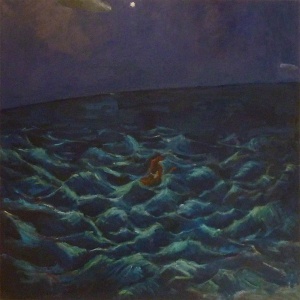
Saar’s two paintings of Jonah present diverse takes on the reluctant prophet. In one small image we first see an enormous dark sea and then only notice a tiny figure sitting on the shore. He considers the enormity of his flight from prophecy or perhaps the depth of God’s wisdom in forcefully bringing him to Nineveh’s shore. Her other Jonah viscerally contemplates the terror of being swallowed. The storm tossed sea surrounds the open jaws of the great fish with Jonah in its mouth, in the exact center of the painting. The surrounding night is calm, a full moon shines in the dark sky over a tilted horizon and suddenly we understand what it feels like to be alone, hopeless and swallowed by God’s will.
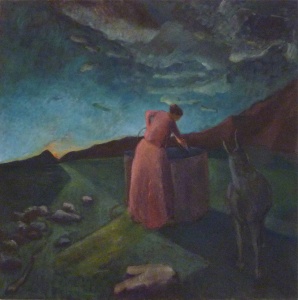
It is perhaps the hazards prophecy that Saar is exploring in these paintings, for her depictions of Miriam all place her at her well surrounded by a vast landscape. While a lone donkey seems to be her companion, not one person accompanies her. Miriam here, drawing water out of the miracle well that follows her through the wilderness, is seen as the ultimate provider of sustenance, the source of life-giving water, tragically doomed to be alone.
These perceptive artists have captured an important element of the tone of the biblical Bamidbar. Raab’s sense of normal Israeli life subtly tainted by the harsh and at times violent political reality reflects the wilderness generation’s mishaps and wandering in more ways than one. Saar interrogates the biblical narrative by finding vignettes outside the literal text but nevertheless reflecting core aspects of its meaning. We are enriched by both artists bold and inventive use of Jewish subject matter to create a vibrant and thoughtful contemporary art.
Paintings by Leah Raab and Shany Saar
NY Studio School, MFA Thesis Exhibition
May 8-22, 2013
